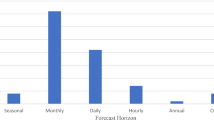Abstract
The analysis of air quality and the continuous monitoring of air pollution levels are important subjects of the environmental science and research. This problem actually has real impact in the human health and quality of life. The determination of the conditions which favor high concentration of pollutants and most of all the timely forecast of such cases is really crucial, as it facilitates the imposition of specific protection and prevention actions by civil protection. This research paper discusses an innovative threefold intelligent hybrid system of combined machine learning algorithms HISYCOL (henceforth). First, it deals with the correlation of the conditions under which high pollutants concentrations emerge. On the other hand, it proposes and presents an ensemble system using combination of machine learning algorithms capable of forecasting the values of air pollutants. What is really important and gives this modeling effort a hybrid nature is the fact that it uses clustered datasets. Moreover, this approach improves the accuracy of existing forecasting models by using unsupervised machine learning to cluster the data vectors and trace hidden knowledge. Finally, it employs a Mamdani fuzzy inference system for each air pollutant in order to forecast even more effectively its concentrations.





Similar content being viewed by others
References
Bougoudis I, Iliadis L, Papaleonidas A (2014) Fuzzy inference ANN ensembles for air pollutants modeling in a major urban area: the Case of Athens. Eng Appl Neural Netw Commun Comput Inf Sci 459(2014):1–14
Breiman L (2001) Random Forests. Mach Learn 45(1):5–32. doi:10.1023/A:1010933404324
Haykin S (2009) Neural networks and learning machines, 3rd edn. New York, Pearson Education
Hooyberghs J, Mensink C, Dumont G, Fierens F, Brasseur O (2005) A neural network forecast for daily average PM10 concentrations in Belgium. Atmos Environ 39(18):3279–3289
Iliadis L (2007) Intelligent information systems and applications in risk estimation. Stamoulis publication, Thessaloniki. ISBN: 978-960-6741-33-3 A
Inal F (2010) Artificial neural network prediction of tropospheric ozone concentrations in Istanbul, Turkey. CLEAN Soil Air Water 38(10):897–908
Jollois FX, Poggi JM, Portier B (2009) Three non-linear statistical methods for analyzing PM10 pollution in Rouen area CS-BIGS 3(1):1–17 CS http://www.bentley.edu/csbigs/documents/poggi.pd
Kadri C, Tian F, Zhang L, Dang L, Li G (2013) Neural network ensembles for online gas concentration estimation using an electronic nose. Int J Comput Sci 10(2):1
Lei KS, Wan F (2012) Applying ensemble learning techniques to ANFIS for air pollution index prediction in Macau. ISNN 2012, Part I, LNCS 7367. pp 509–516
Kohonen Τ (1989) Self-organization and associative memory, 3rd edn. Springer, Berlin
Singha KP, Guptaa S, Rai P (2013) Identifying pollution sources and predicting urban air quality using ensemble learning methods. Atmos Environ 80:426–437
Lopez M, Melin P, Castillo O (2007) A method for creating ensemble neural networks using a sampling data approach. Theor Adv Appl Fuzzy Log ASC42 pp. 772–780, Springer
Maclin R, Opitz D (1999) Popular ensemble methods: an empirical study. J Artif Intell Res 11:169–198
Mamdani EH, Assilian S (1975) An experiment in linguistic synthesis with a fuzzy logic controller. Int J Man Mach Stud 7(1):1–13
Mamdani EH (1974) Application of fuzzy algorithms for the control of a simple dynamic plant. In: Proceedings of IEEE, pp 121–159
Ordieres Meré JB, Vergara González EP, Capuz RS, Salaza RE (2005) Neural network prediction model for fine particulate matter (PM). Environ Modell Softw 20:547–559
Ozcan HK, Bilgili E, Sahin U, Bayat C (2007) Modeling of trophospheric ozone concentrations using genetically trained multi-level cellular neural networks. Adv Atmos Sci Springer 24(5):907–914
Ozdemir H, Demir G, Altay G, Albayrak S, Bayat C (2008) Environ Eng Sci 25(9):1249–1254
Paoli C (2011) A neural network model forecasting for prediction of hourly ozone concentration in Corsica. In: Proceedings IEEE of the 10th International Conference on Environment and Electrical Engineering (EEEIC)
Paschalidou A, Iliadis L, Kassomenos P, Bezirtzoglou C (2007) Neural modeling of the tropospheric ozone concentrations in an urban site. In: 10th ICEANN, pp 436–445
Robles LA, Ortega JC, Fu JS, Reed GD, Chow JC, Watson JG, Moncada-Herrera JA (2008) A hybrid ARIMA and artificial neural networks model to forecast particulate matter in urban areas: the case of Temuco, Chile. Atmos Environ 42(35):8331–8340
Rokach L (2010) Ensemble-based classifiers. Artif Intell Rev 33(1–2):1–39. doi:10.1007/s10462-009-9124-7
Roy S (2012) Prediction of particulate matter concentrations using artificial neural network. Resour Environ 2(2):30–36. doi:10.5923/j.re.20120202.05
Takagi Τ, Sugeno M (1985) Fuzzy identification of systems and its applications to modeling and control. IEEE Trans Syst Man Cybern SMC-15(1):116–133
Wahab A-SA, Al-Alawi SM (2002) Assessment and prediction of tropospheric ozone concentration levels using artificial neural networks. EM & Softw 17:219–228
Zhou ZH, Wu J, Wei T (2010) Corrigendum to “Ensembling neural networks: many could be better than all”. Artif Intell 174(18):1570
Author information
Authors and Affiliations
Corresponding author
Rights and permissions
About this article
Cite this article
Bougoudis, I., Demertzis, K. & Iliadis, L. HISYCOL a hybrid computational intelligence system for combined machine learning: the case of air pollution modeling in Athens. Neural Comput & Applic 27, 1191–1206 (2016). https://doi.org/10.1007/s00521-015-1927-7
Received:
Accepted:
Published:
Issue Date:
DOI: https://doi.org/10.1007/s00521-015-1927-7




